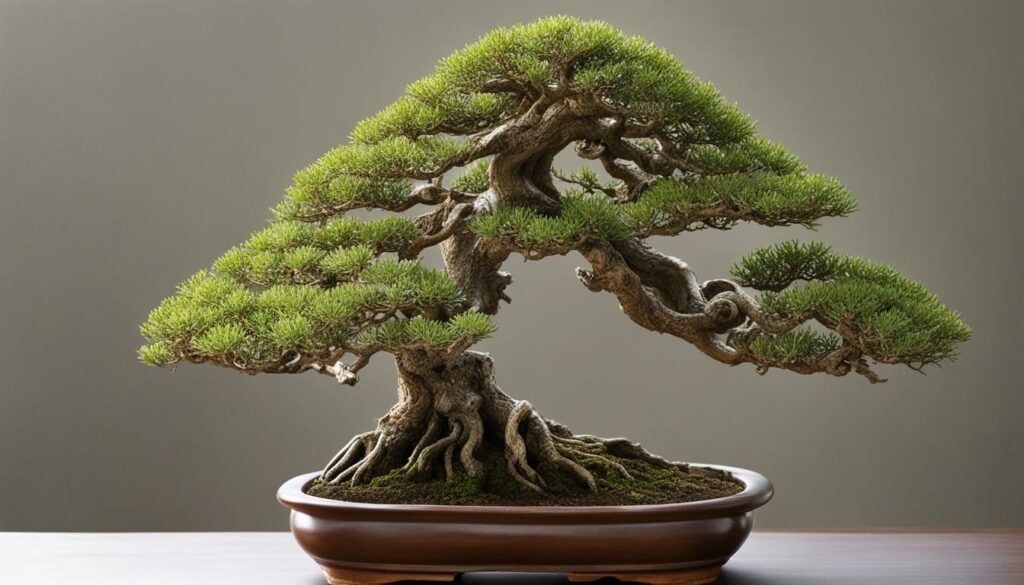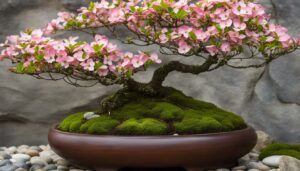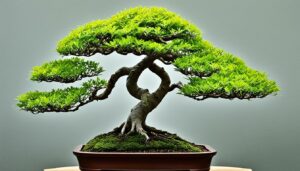In this article, you will learn all about the captivating Bonsai Tree Species Olive. This stunning Mediterranean bonsai, scientifically known as Olea europaea, is a beloved species among bonsai enthusiasts. From its historical significance to care techniques and symbolism, this article will cover the essential aspects you need to know about this cherished tree.
Key Takeaways:
- The Olive Bonsai is a captivating Mediterranean species highly regarded in the art of bonsai.
- The history and cultural significance of the Olive Bonsai date back centuries.
- The Olive Bonsai is associated with peace, longevity, and abundance.
- Choosing a healthy and suitable tree is crucial for an optimal Olive Bonsai experience.
- Maintaining proper care techniques is essential for a thriving and stunning Olive Bonsai.
Origins of the Olive Bonsai
The Bonsai Tree Species Olive, known by its scientific name Olea europaea, has been cultivated as a bonsai for centuries. Its origins can be traced back to the Mediterranean region, where the tree was highly valued for its fruit and oil. Ancient civilizations, such as the Greeks and Romans, revered the olive tree and considered it a symbol of peace, wisdom, and victory.
To create an Olive Bonsai, growers would carefully trim and shape the tree’s branches and roots to maintain its miniature size and delicate appearance. The art of bonsai cultivation spread throughout Asia and Europe, with the Olive Bonsai remaining a popular choice among gardeners and enthusiasts.
Cultural Significance
“The olive trees represent peace and stability, and are a symbol of wisdom and prosperity.” – Patrick Leahy
The Olive Bonsai’s cultural significance extends beyond its historical roots in the Mediterranean. In Japan, the art of bonsai is highly regarded and celebrated, and the olive tree has become a popular addition to the country’s bonsai gardens. The tree’s enduring qualities, such as its longevity, resilience, and beauty, make it a cherished symbol of growth and harmony.
Distinctive Features
The Olive Bonsai is known for its small, ovate leaves and its grayish-green bark, which can become more gnarled and twisted with age. Its delicate, white flowers bloom in the spring and give way to small, oblong fruit that ripens in the fall. When placed in a decorative container, the Olive Bonsai can add a touch of natural elegance to any indoor or outdoor space.
Symbolism and Meaning
When it comes to the Olive Bonsai, its symbolic meaning is just as impressive as its appearance. This Mediterranean bonsai species, scientifically known as Olea europaea, is associated with peace, longevity, and abundance. It is no wonder that the Olive Bonsai is highly regarded in the art of bonsai and gardening.
Peace: The Olive Bonsai carries a great significance due to its connection with the olive branch. In ancient times, the olive branch was a symbol of peace and was used during times of war to symbolize the desire for a peaceful resolution. Even today, the Olive Bonsai is still recognized as a symbol of peace.
Longevity: The Olive Bonsai is also associated with longevity due to its impressive lifespan. With proper care, an Olive Bonsai can live for hundreds of years, making it a symbol of strength, resilience, and durability.
Abundance: The Olive Bonsai is also considered a symbol of abundance, as the olive tree produces a bountiful harvest of fruit. Known for its nutritional value, the olive is also a staple in Mediterranean cuisine and culture.
Infographic: Symbolism and Meaning of the Olive Bonsai
| Symbolic Meaning | Description |
|---|---|
| Peace | Symbolizes peace and tranquility due to its connection with the olive branch. |
| Longevity | A symbol of strength and resilience due to its impressive lifespan of hundreds of years. |
| Abundance | A symbol of abundance and prosperity due to its bountiful harvest of fruit. |
As you can see, the Olive Bonsai is much more than just a beautiful plant. It carries a rich history and holds deep symbolic meaning in various cultures. By incorporating an Olive Bonsai into your garden or home, you can create a peaceful and abundant environment that is both visually stunning and highly meaningful.
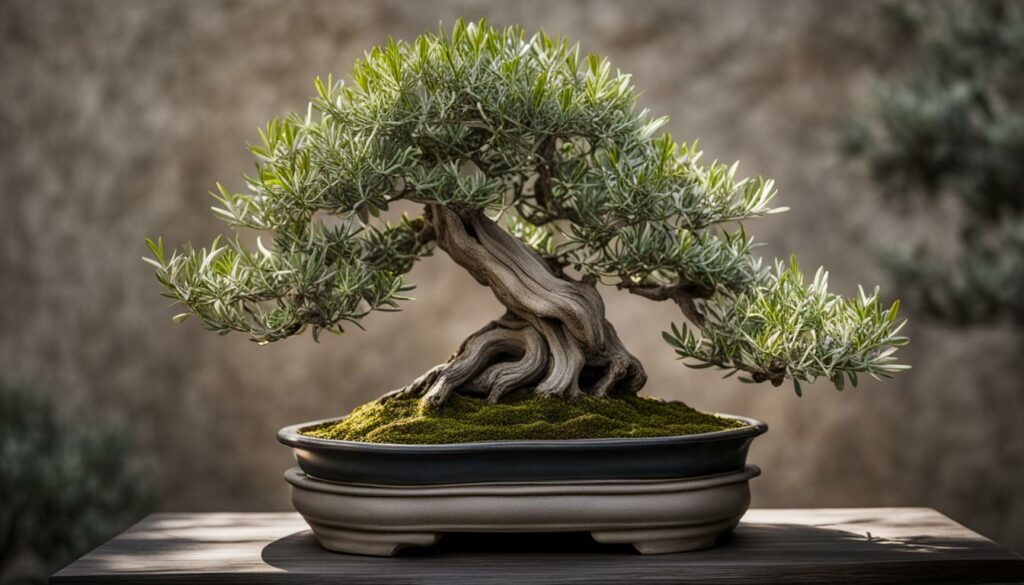
Selecting the Perfect Olive Bonsai
Choosing the right Olive Bonsai for your garden involves several key considerations. The first step is to determine the size and shape of the bonsai that best fits your preferences and available space. Larger Olive Bonsai trees can be impressive focal points but require more maintenance.
Next, examine the health of the tree before purchasing. Look for signs of pests or diseases such as wilting leaves or discoloration. Inspect the roots, ensuring they are well-developed and distributed evenly throughout the soil.
When selecting an Olive Bonsai, consider its age and training. Younger trees are easier to shape and style but may take longer to mature. Trees with advanced styling techniques may be more expensive, but they offer a more refined aesthetic.
Finally, choose a soil and fertilizer suitable for Mediterranean bonsai such as Olea europaea. Consult with a bonsai expert or reference guide on appropriate care practices.
Bonsai Care Basics
As with any plant, proper care is essential for the health and growth of your Olive Bonsai. Below are some essential techniques to consider:
Watering
Make sure your Olive Bonsai is watered regularly. The frequency of watering depends on the size of your Olive Bonsai, the type of soil you are using, and the climate in which you live. Generally, you should water your Mediterranean bonsai when the topsoil feels dry to the touch. Be sure not to overwater, as this can lead to root rot and other issues.
Sunlight Requirements
Olive bonsais require bright, indirect sunlight. Place your bonsai in a location where it receives at least six hours of sunlight daily. Too little light can cause your bonsai to weaken, while too much direct sunlight can scorch the leaves and cause damage.
Pruning
Pruning is a crucial part of caring for your Olive Bonsai. Regular pruning helps to keep your bonsai in shape, promotes growth, and removes dead or dying branches. Use sharp shears and cut back to a live leaf or bud.
Repotting
Repotting Olive bonsai is necessary every two to three years. The best time to repot your bonsai is in the spring when the tree is actively growing. Choose a slightly larger container than the previous one, and use fresh soil with added organic matter.
Tip: Always remember to observe your Olive Bonsai carefully and adjust your care techniques based on its specific needs.
Shaping and Styling the Olive Bonsai
Creating stunning and unique designs is an essential part of bonsai cultivation. Shaping and styling your Olive Bonsai is a rewarding process that requires patience, skill, and creativity. Through various techniques like wiring, pruning, and trimming, you can achieve the desired aesthetic and enhance the tree’s natural form.
To shape your Olive Bonsai, you need to consider the tree’s natural growth patterns and the desired design.
Wiring is a popular technique used to create bends and curves in the branches of your Olive Bonsai. The wire is wrapped around the branch and gently bent into the desired shape. Take care not to damage the branch by bending too far or using too much wire. After a few months, the wire can be removed as the branch retains its new shape.
Pruning and trimming are necessary for maintaining the tree’s shape and removing any unwanted growth. Always use clean and sharp tools to avoid damaging the tree. Make sure to prune branches at the right length and angle to maintain the desired shape and avoid creating scars or wounds.
“The art of styling and shaping a bonsai tree requires not only skill but also a deep appreciation for the beauty of nature.”
When shaping your Olive Bonsai, it’s essential to consider the tree’s age, size, and growth stage. Younger trees are more flexible and easier to shape, whereas older trees may require more pruning and wiring to achieve the desired form.
Always keep in mind that shaping and styling your Olive Bonsai is an ongoing process that requires regular maintenance and adjustment to preserve the tree’s health and beauty.
Overcoming Common Challenges
Caring for your Olive Bonsai can present some challenges, but with the right approach and knowledge, you can ensure the health and longevity of your tree. Here are some common issues that you may face and effective solutions to overcome them:
Pests and Diseases
Like other plants, Olive Bonsai is susceptible to pests and diseases. Common pests include spider mites, scale insects, and aphids. To prevent infestations, inspect your tree regularly and keep it clean and healthy. If you notice any signs of pests, such as webbing or sticky residue, treat the affected areas with organic insecticides or neem oil.
Diseases that may affect your Olive Bonsai include root rot, fungal infections, and bacterial diseases. To avoid these issues, make sure to provide proper soil drainage and avoid overwatering your tree. In case of disease, carefully remove the affected parts and treat the area with a fungicide or bactericide.
Weather Conditions
The Mediterranean origins of the Olive Bonsai make it well-suited to warm and sunny climates. However, extreme temperatures and weather conditions can pose a threat to its health. To protect your tree during hot or cold spells, place it in a suitable location with proper ventilation and shade. You can also cover it with a cloth or blanket during frosty nights.
Soil and Nutrient Management
The soil and nutrients that your Olive Bonsai receives are crucial for its growth and development. Use well-draining soil that contains a mix of organic matter and inorganic material such as sand or perlite. Avoid over-fertilizing your tree, as this can cause root burn and damage. Use a balanced, slow-release fertilizer and follow the instructions carefully.
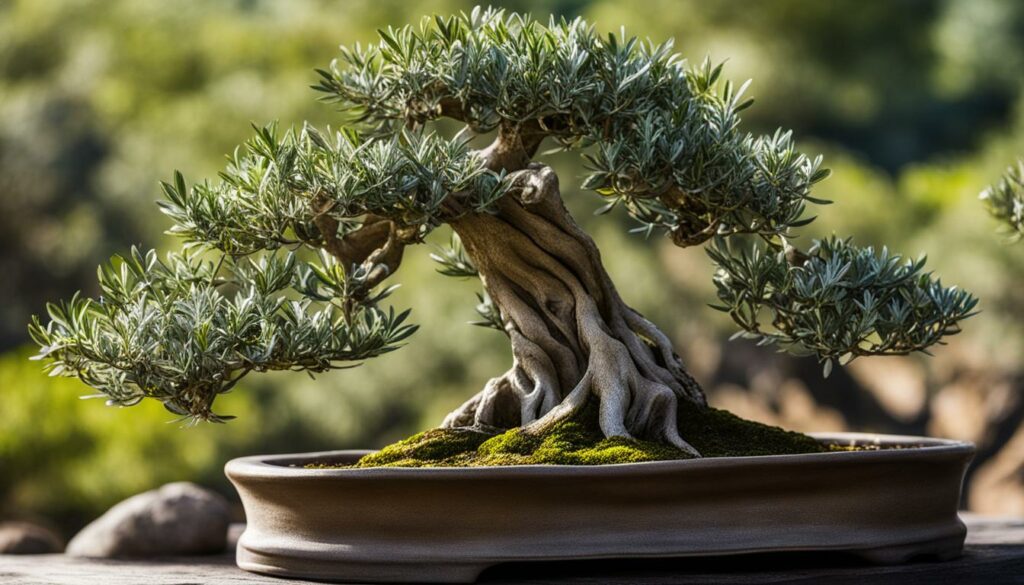
By being proactive and addressing these common challenges, you can ensure that your Olive Bonsai thrives and remains a beautiful and cherished addition to your garden.
Winter Care for the Olive Bonsai
Winter can be a challenging time for the Mediterranean bonsai. Without proper care, the chilly temperatures and frost can harm the delicate olive tree. Below are some tips to keep your Olea europaea healthy and strong during the winter season:
Protecting against frost
When temperatures drop below freezing, the soil in your bonsai’s pot can freeze, causing damage to the roots. To prevent this, cover the soil with an insulating layer of mulch or straw. You can also use a frost cloth or a blanket to cover the entire tree and protect it from frostbite.
Reducing watering frequency
In the winter, the Olive Bonsai goes into a dormant state and requires less water. It’s important to reduce watering frequency during this time to avoid overwatering or freezing the roots.
Providing sufficient sunlight
Mediterranean bonsai thrives in direct sunlight, even in the winter. Ensure that your Olive Bonsai receives sufficient sunlight, ideally 4-6 hours daily, to maintain its health and vitality. Place it near a south-facing window or under grow lights if needed.
Pruning and wiring
Winter is an ideal time to prune your Olive Bonsai to maintain its shape and promote healthy growth. Use sharp, clean pruning shears to cut off any dead, weak or unhealthy branches. Be careful not to remove more than 25% of the foliage, as this can weaken the tree. You can also use wiring to shape the tree while it’s in its dormant state.
Overwintering
If you live in an area with severe winter conditions, consider overwintering your Olive Bonsai indoors. The tree should be placed in a cool, dark location such as a garage or basement and watered occasionally to keep the roots from drying out. Ensure that the location is well ventilated and doesn’t experience extreme temperature fluctuations.
Displaying the Olive Bonsai
The Olive Bonsai is a stunning addition to any indoor or outdoor space. When it comes to displaying your Olive Bonsai, there are several factors to consider to enhance the overall aesthetic and impact of the tree.
Containers
Choosing the right pot or container is crucial in displaying your Olive Bonsai. Make sure the container is the correct size and provides adequate drainage. Terra-cotta and ceramic pots are popular choices, but you can also opt for wooden or bamboo containers for a more natural look.
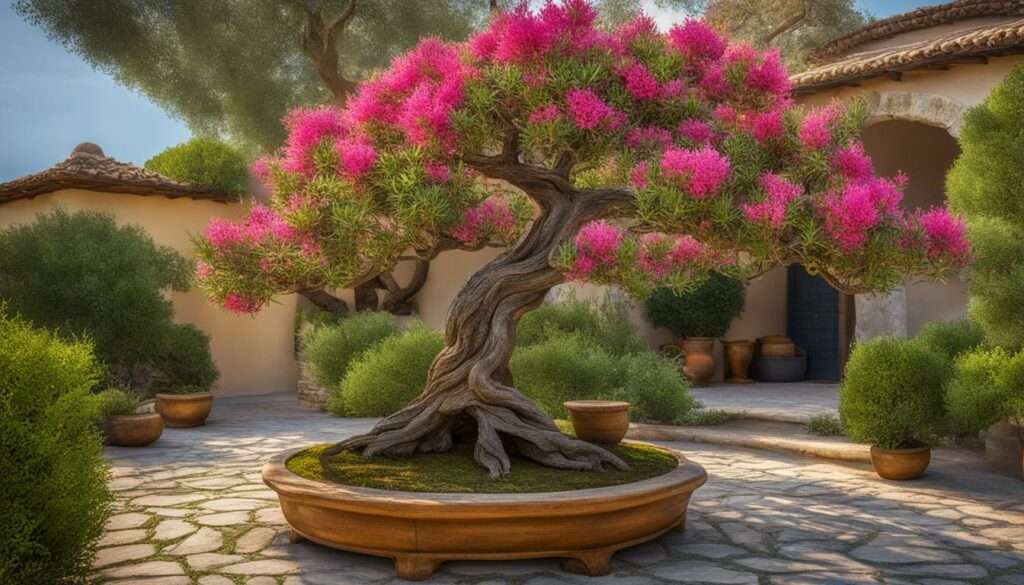
Stands
Using a stand can elevate your Olive Bonsai and provide a focal point in any space. There are various types of stands available, including wooden, metal, and acrylic. Consider the style and color of the stand to complement the look of the Olive Bonsai and its container.
Positioning
The positioning of your Olive Bonsai is also an important aspect of displaying it. Make sure the tree is positioned to receive the right amount of light and humidity. Avoid placing it near air vents or heating sources that can dry out the soil and branches.
Indoor vs. Outdoor
The Olive Bonsai can thrive both indoors and outdoors. If you choose to display it indoors, make sure it receives enough natural light and ventilation. If you display it outdoors, protect it from extreme temperatures and strong winds.
Propagation Techniques for Olive Bonsai
Expanding your bonsai collection can be a rewarding experience, and learning how to propagate the Olive Bonsai is an excellent way to do it. There are three main methods to propagate Olive Bonsai trees: seed germination, cuttings, and air layering.
Seed Germination
Starting Olive Bonsai trees from seeds can be a challenging process due to their hard shell and low germination rate. However, if successful, it allows you to grow a unique tree with a deep taproot. To germinate seeds, you will need to scar the seed’s outer layer and soak them in water for a few days before planting them in well-draining soil.
Cuttings
Cuttings are an effective way to propagate Olive Bonsai trees quickly. When taking cuttings, select a healthy new growth from the mother plant and cut a 4-6 inch piece. Remove any leaves, keeping only a few at the top, and dip the end in rooting hormone before planting in soil.
Air Layering
Air layering is the most challenging but most effective propagation method. This technique involves peeling off the bark around a branch and wrapping the exposed portion with peat moss and plastic wrap. Over time, roots grow in the moss, and a new tree forms. Once the new tree has established roots, you can cut it off from the mother plant and pot it in soil.
With the right care and attention, propagating your Olive Bonsai can lead to a beautiful collection of these Mediterranean bonsai trees.
Preserving the Art of Olive Bonsai
As with all forms of art, it is crucial to preserve the ancient tradition of cultivating Olive Bonsai. Through various organizations, exhibitions, and resources, enthusiasts can learn about the history, symbolism, and care techniques of this beloved bonsai species.
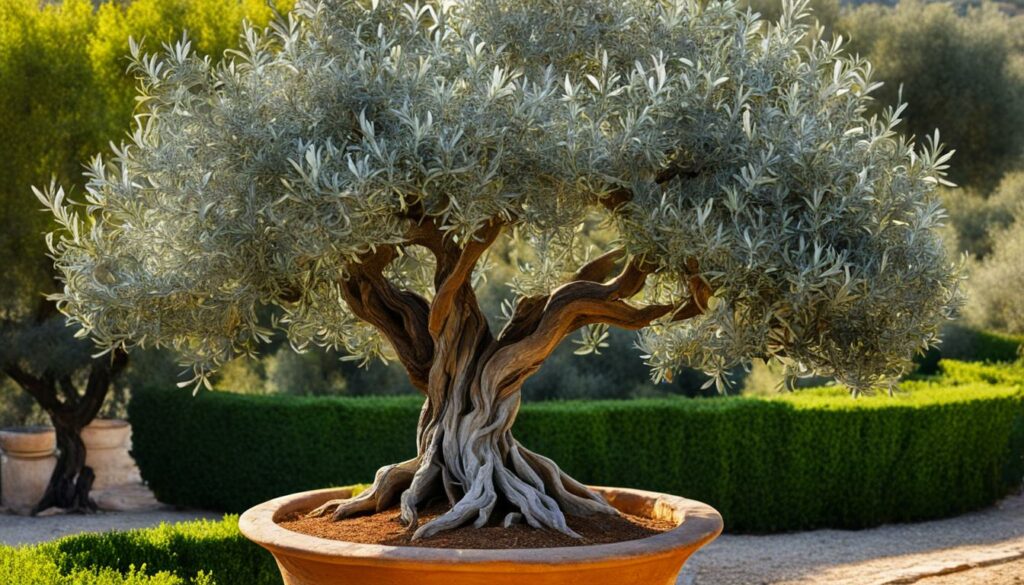
One such organization is the North American Bonsai Federation (NABF), which aims to promote bonsai appreciation and knowledge through education and outreach. The National Bonsai Foundation (NBF), located in Washington D.C., is another organization dedicated to preserving the art of bonsai through its National Bonsai & Penjing Museum.
“Preserving the art of bonsai is essential for maintaining the cultural heritage and beauty that bonsai brings to our lives.” – John Yoshio Naka, Bonsai Master
There are also various exhibitions, such as the US National Bonsai Exhibition, which showcases beautiful and unique bonsai displays from all over the United States. Through the sharing of knowledge and the appreciation of the art, we can ensure that the Olive Bonsai and other bonsai species continue to thrive for generations to come.
Conclusion
Congratulations, you have completed the journey of discovering the fascinating world of the Bonsai Tree Species Olive.
You have learned about the historical significance, care techniques, and symbolism associated with this ancient and cherished bonsai species. The Olive Bonsai has its roots in the Mediterranean region and has been cultivated for centuries, making it a significant cultural symbol in various regions.
The Olive Bonsai represents peace, longevity, and abundance, making it a highly regarded bonsai species in the art of gardening and bonsai cultivation. It requires attention and care to thrive, but with the right techniques, you can maintain a healthy and vibrant Olive Bonsai.
Remember to consider key factors such as size, shape, and health when selecting the perfect Olive Bonsai for your garden. You can also explore different techniques such as wiring, pruning, and trimming to achieve the desired aesthetic.
Finally, preserving the art of Olive Bonsai cultivation is crucial. There are organizations, exhibitions, and resources dedicated to promoting bonsai appreciation and knowledge, ensuring that this ancient art form continues to thrive for generations to come.
FAQ
What is the Olive Bonsai?
The Olive Bonsai, also known as the Mediterranean bonsai or Olea europaea, is a bonsai tree species that has been cultivated for centuries. It is a miniature version of the olive tree and is cherished for its historical significance and symbolism.
What is the historical significance of the Olive Bonsai?
The olive tree has deep historical and cultural significance in the Mediterranean region. It has been revered for its sacred symbolism, representing peace, longevity, and abundance. The Olive Bonsai carries on this tradition and serves as a living connection to the past.
How do I select the perfect Olive Bonsai?
When selecting an Olive Bonsai, consider factors such as the size and shape of the tree, as well as its overall health. Look for a bonsai that suits your preferences and needs, and ensure that it has been well cared for.
What are the basic care requirements for an Olive Bonsai?
To care for an Olive Bonsai, it is essential to provide adequate watering, sunlight, and regular pruning. The tree should be placed in a sunny location and watered when the soil feels dry. Pruning helps maintain the desired shape and size of the bonsai.
How do I shape and style the Olive Bonsai?
Shaping and styling the Olive Bonsai involves techniques such as wiring, pruning, and trimming. By carefully manipulating the branches and foliage, you can create unique designs and achieve the desired aesthetic for your bonsai.
What are some common challenges associated with caring for an Olive Bonsai?
Common challenges include dealing with pests and diseases, as well as adapting to weather conditions. It is important to regularly inspect your bonsai for signs of any issues and take appropriate measures to address them.
How should I care for my Olive Bonsai during winter?
During the winter season, it is crucial to protect your Olive Bonsai from frost and cold temperatures. This can be done by placing it in a sheltered location, providing insulation, and adjusting watering practices to accommodate the tree’s dormant stage.
How can I display my Olive Bonsai?
There are various ways to showcase your Olive Bonsai, both indoors and outdoors. Choose a suitable container and position it in an area that highlights its beauty. Consider using stands or display tables to elevate the bonsai and enhance its visual impact.
What are the propagation techniques for the Olive Bonsai?
Propagation methods for the Olive Bonsai include seed germination, cuttings, and air layering. Each technique has its own requirements and challenges, but with proper knowledge and care, you can successfully propagate new trees and expand your bonsai collection.
How can I preserve the art of Olive Bonsai cultivation?
Preserving the art of Olive Bonsai cultivation involves sharing knowledge, participating in bonsai organizations and exhibitions, and utilizing available resources. By actively engaging in the community and promoting appreciation for bonsai, we can ensure its continuation for future generations.
